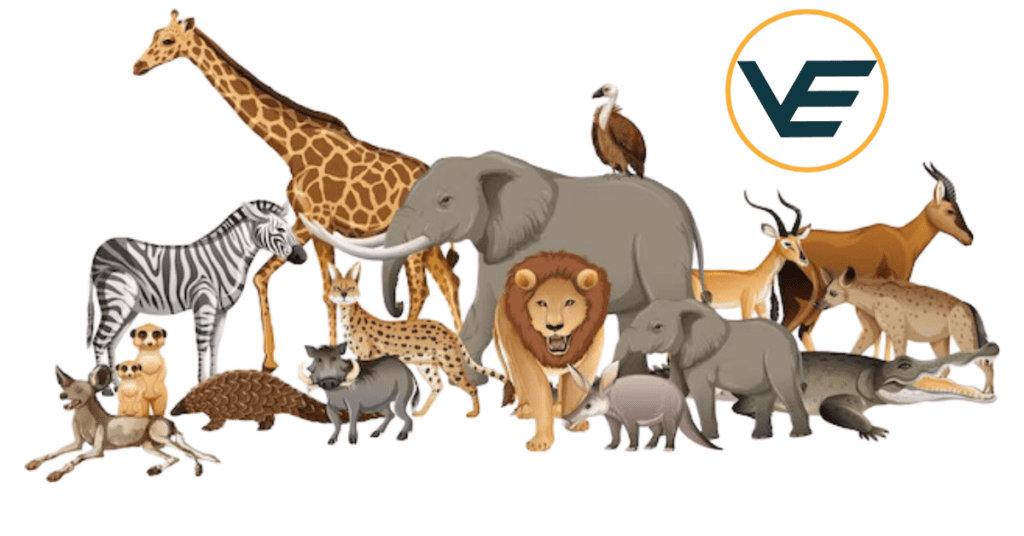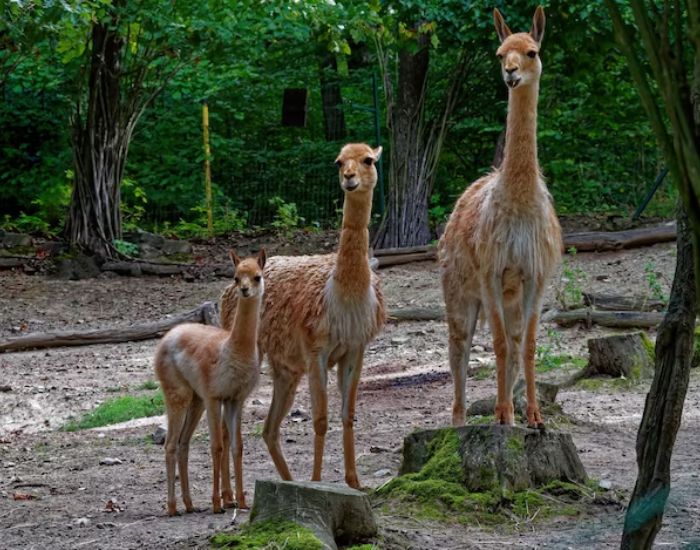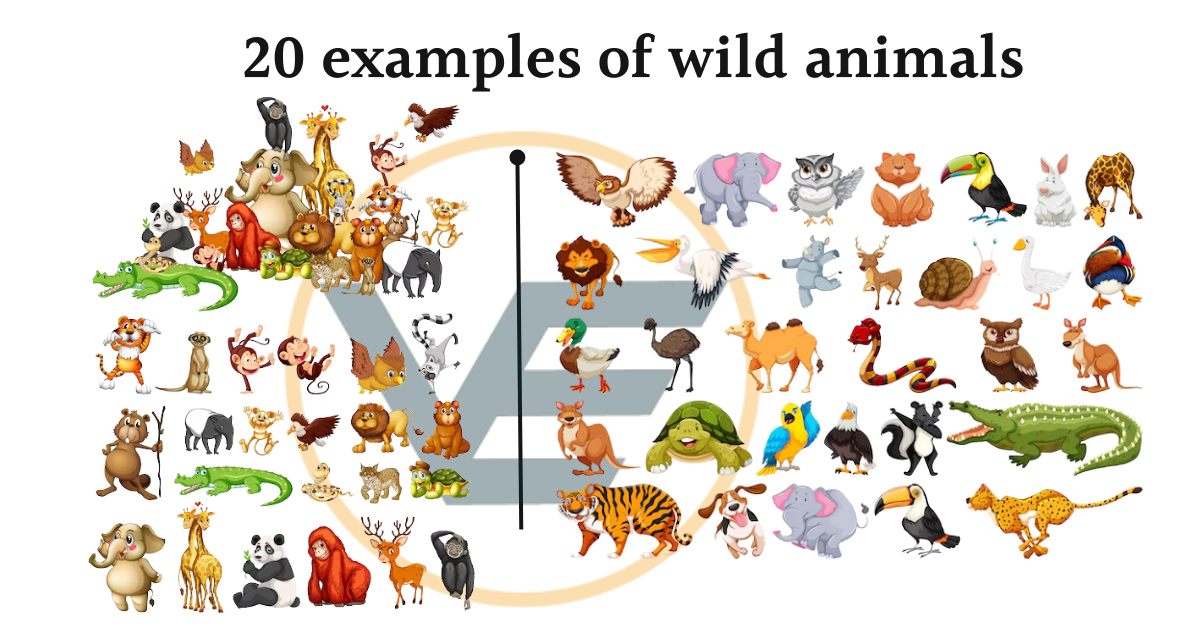Lion, Elephant, Tiger, Giraffe, Panda, Kangaroo, Gorilla, Cheetah, Humpback, Whale, Polar Bear, Leopard, and Wolf are examples of wild animals.
Definition of Wild Animals
Wild animals refer to organisms that live and thrive in their natural habitats, without direct human intervention or domestication. These creatures have not undergone significant genetic changes due to human breeding practices, unlike domesticated animals. Wild animals can be found in various ecosystems, including forests, grasslands, deserts, oceans, and freshwater environments.
Also Read: Examples of Viviparous Animals
Characteristics of Wild Animals
Some characteristics of wild animals are given below;
- Adaptations: Wild animals are well-adapted to their specific environments, with physical and behavioral traits that help them survive in their natural habitats.
- Self-Sufficiency: They rely on instinct, innate behaviors, and hunting or foraging skills to find food, water, and shelter without human assistance.
- Natural Predators and Prey: Many wild animals participate in predator-prey relationships, forming a delicate balance within ecosystems.
- Genetic Diversity: Wild animals generally have higher genetic diversity compared to domesticated species, which contributes to their ability to adapt to changing environmental conditions.
- Free-Ranging: Wild animals move and roam freely within their territories, and their natural movements are not confined by human-made structures.
- Ecological Importance: Wild animals play crucial roles in ecological processes, such as pollination, seed dispersal, and nutrient cycling, which maintain ecosystem health and balance.
- Conservation Value: As vital components of biodiversity, wild animals are essential for conservation efforts to protect natural habitats and preserve endangered species.
- Limited Human Interaction: Wild animals typically have minimal direct contact with humans, living independently in the wild and exhibiting natural behaviors.
Examples of Wild Animals

There are many wild animals in the world. Top and popular examples of wild animals are given below;
| African Elephant | Savannahs, Forests | Herbivore | Social, lives in herds, uses trunk for various tasks | Vulnerable |
| Bengal Tiger | Jungles, Grasslands | Carnivore | Solitary, excellent swimmer, ambush predator | Endangered |
| Polar Bear | Arctic Regions | Carnivore | Semi-aquatic, hunts seals on ice | Vulnerable |
| Giant Panda | Bamboo Forests | Herbivore | Solitary, feeds on bamboo shoots | Vulnerable |
| Cheetah | Grasslands, Savannas | Carnivore | Fastest land animal, hunts by speed | Vulnerable |
| Giraffe | Savannahs | Herbivore | Tallest land animal, long neck for reaching leaves | Vulnerable |
| Koala | Eucalyptus Forests | Herbivore | Arboreal, sleeps most of the day, eats eucalyptus leaves | Vulnerable |
| Gray Wolf | Forests, Tundras | Carnivore | Pack hunter, highly social | Least Concern |
| Snow Leopard | Mountainous Regions | Carnivore | Solitary, elusive, adapted to high altitudes | Vulnerable |
| Kangaroo | Grasslands, Forests | Herbivore | Marsupial, powerful hind legs, hop locomotion | Least Concern |
| Orangutan | Rainforests | Omnivore | Arboreal, highly intelligent, uses tools | Critically Endangered |
| African Lion | Savannahs | Carnivore | Social, lives in prides, apex predator | Vulnerable |
| Blue Whale | Oceans | Carnivore | Largest animal on Earth, filter-feeder | Endangered |
| Red Fox | Forests, Grasslands | Omnivore | Nocturnal, adaptable, opportunistic hunter | Least Concern |
| Nile Crocodile | Rivers, Lakes | Carnivore | Ambush predator, powerful jaws, lays eggs on riverbanks | Least Concern |
| Golden Eagle | Mountains, Open Country | Carnivore | Powerful raptor, excellent eyesight | Least Concern |
| Komodo Dragon | Islands in Indonesia | Carnivore | Largest lizard, venomous bite | Vulnerable |
| Grizzly Bear | Forests, Tundras | Omnivore | Solitary, powerful, hibernates in winter | Least Concern |
| Zebra | Grasslands, Savannas | Herbivore | Social, striped coat for camouflage | Least Concern |
| Platypus | Rivers, Streams | Carnivore | Egg-laying mammal, unique bill, webbed feet | Least Concern |
Common Examples of Wild Animals
Sure, here are some examples of wild animals:
- Lion: Known as the king of the jungle, lions are found in many parts of Africa.
- Elephant: The largest land animal, elephants are known for their intelligence and long memory.
- Tiger: Tigers are the largest members of the cat family and are renowned for their power and strength.
- Bear: Bears are found in many parts of the world, from the polar regions to the forests of North America and Europe.
- Wolf: Wolves are known for their pack behavior and howling communication.
- Giraffe: The tallest animal on land, giraffes are known for their long necks and legs.
- Zebra: Zebras are known for their black and white stripes, each individual’s pattern is unique.
- Kangaroo: Native to Australia, kangaroos are known for their powerful hind legs and long tails.
- Panda: Native to China, pandas are known for their love of bamboo.
- Monkey: Monkeys are found in many parts of the world and are known for their agility and intelligence.
- Leopard: Leopards are known for their ability to adapt to various habitats and their stealthy hunting skills.
- Alligators: Alligators are large reptiles known for their armored bodies and powerful jaws.
- Eagle: Eagles are large birds of prey known for their excellent eyesight.
- Dolphins: Dolphins are known for their intelligence and playful behavior.
- Snake: Snakes are found all over the world and are known for their legless, elongated bodies.
- Crocodile: Crocodiles are large aquatic reptiles known for their strong bite.
- Hippopotamus: Hippos are large, mostly herbivorous mammals known for their large size and semi-aquatic lifestyle.
- Rhinoceros: Rhinos are known for their large size and the horn on their nose.
- Cheetah: The fastest land animal, cheetahs are known for their incredible speed and agility.
- Penguin: Penguins are flightless birds known for their swimming abilities and living in cold climates.
Role of Wild Animals in Ecosystem

- Lion (Panthera leo): Majestic carnivores found in African savannas, known for their social structure and hunting prowess.
- Elephant (Loxodonta africana and Elephas maximus): The largest land animals, known for their intelligence, memory, and strong family bonds.
- Tiger (Panthera tigris): Powerful predators with distinctive striped coats, found in various habitats across Asia.
- Giraffe (Giraffa camelopardalis): Graceful herbivores with long necks and spotted coats, native to African grasslands.
- Panda (Ailuropoda melanoleuca): Iconic black and white bears native to the bamboo forests of China.
- Kangaroo (Macropus spp.): Marsupials found primarily in Australia, known for their powerful hind legs and unique mode of locomotion.
- Gorilla (Gorilla gorilla): Largest primates inhabiting African forests, distinguished by their strength and gentle nature.
- Cheetah (Acinonyx jubatus): Speedy predators capable of reaching high running speeds, found in African grasslands.
- Humpback Whale (Megaptera novaeangliae): Large marine mammals known for their acrobatic behaviors and haunting songs.
- Polar Bear (Ursus maritimus): Arctic-dwelling carnivores, superbly adapted to life on sea ice and proficient swimmers.
- Leopard (Panthera pardus): Stealthy big cats with distinctive rosette patterns, found in various habitats across Africa and Asia.
- Wolf (Canis lupus): Highly social carnivores, once widespread but now found in reduced populations in various regions.
- Orangutan (Pongo spp.): Arboreal great apes native to the rainforests of Southeast Asia, known for their intelligence and tool use.
- Zebra (Equus zebra): Striped herbivores found in African grasslands, known for their unique black-and-white coats.
- Koala (Phascolarctos cinereus): Tree-dwelling marsupials native to Australia, feeding primarily on eucalyptus leaves.
- Jaguar (Panthera onca): Stealthy big cats native to the Americas, known for their strength and aquatic abilities.
- Penguin (Spheniscidae family): Flightless birds adapted to marine life, inhabiting the Southern Hemisphere.
- Rhinoceros (Rhinocerotidae family): Large herbivores with distinctive horn(s), found in Africa and Asia.
- Giant Panda (Ailuropoda melanoleuca): Endangered bears native to the bamboo forests of China.
- Gazelle (Gazella spp.): Graceful antelopes found in various regions, known for their speed and agility.
These wild animals represent a fraction of the incredible diversity of wildlife inhabiting our planet. They play crucial roles in their respective ecosystems, contributing to the balance and richness of the natural world.

